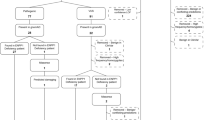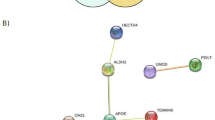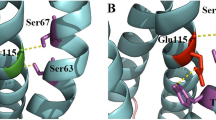Abstract
Mevalonate kinase deficiency (MKD) is an autosomal recessive inflammatory disease. Mutations in MVK gene are associated with MKD with modest genotype–phenotype correlation. In spite of recent guidelines indicating specific MVK mutations for the more severe form or the milder one, little is known about MVK variability within and between populations. The aim of this work is to provide supplementary information about MVK variability useful in the molecular diagnosis of MKD, as well as to unravel the presence of novel genes potentially involved as involved in the clinical heterogeneity of MKD phenotype. We used a population-based approach, coupled with Combined Annotation–Dependent Depletion (CADD) score, to analyze the level of genetic variability for common and putatively deleterious MVK variants. We also performed Exome screening with the Illumina Human Exome Bead Chip on 21 MKD patients to double-check our in silico findings. Haplotype block detection in different populations revealed the existence of two blocks in MVK; interestingly, the first haploblock comprises the promoter region shared with MMAB gene. Analyses of MMAB and MVK genetic variants in 21 MKD patients strengthen our observations showing a novel scenario in which the same mutations commonly associated with MKD are found coupled with different combination of MMAB rs7134594 SNP was already described as associated with HDL cholesterol level and present in the haploblock promoter region. The rs7134594 SNP is reported as an eQTL for MVK and MMAB. Hypothesizing the presence of genetic variants modulating the complex phenotypic spectrum of MKD, we suggest that future directions in screening for MKD pathogenic variants should focus both MMAB and MVK genes.


Similar content being viewed by others
References
Bader-Meunier B, Florkin B, Sibilia J et al (2011) Mevalonate kinase deficiency: a survey of 50 patients. Pediatrics 128:e152–e159
Haas D, Hoffmann GF (2006) Mevalonate kinase deficiencies: from mevalonic aciduria to hyperimmunoglobulinemia D syndrome. Orphanet J Rare Dis 1:1
De Pieri C, Taddio A, Insalaco A et al (2014) Different presentations of mevalonate kinase deficiency: a case series. Clin Exp Rheumatol 33:437–442
Browne C, Timson DJ (2015) In silico prediction of the effects of mutations in the human mevalonate kinase gene: towards a predictive framework for mevalonate kinase deficiency. Ann Human Genet 79:451–459
Stabile A, Compagnone A, Napodano S, Raffaele CG, Patti M, Rigante D (2012) Mevalonate kinase genotype in children with recurrent fevers and high serum IgD level. Rheumatol Int 33:3039–3042
Celsi F, Tommasini A, Crovella S (2014) “Hyper-IgD syndrome” or “mevalonate kinase deficiency”: an old syndrome needing a new name? Rheumatol Int 34:423–424
Moura R, Tricarico PM, Coelho AVC, Crovella S (2015) GRID2 a novel gene possibly associated with mevalonate kinase deficiency. Rheumatol Int 35:657–659
Murphy C, Murray AM, Meaney S, Gåfvels M (2007) Regulation by SREBP-2 defines a potential link between isoprenoid and adenosylcobalamin metabolism. Biochem Biophys Res Commun 355:359–364
Celsi F, Piscianz E, Romano M, Crovella S (2015) Knockdown of MVK does not lead to changes in NALP3 expression or activation. J Inflamm 12:1
Consortium GP (2012) An integrated map of genetic variation from 1092 human genomes. Nature 491:56–65
Wright S (1951) The genetical structure of populations. Ann Eugen 15:323–354
Benazzo A, Panziera A, Bertorelle G (2015) 4P: fast computing of population genetics statistics from large DNA polymorphism panels. Ecol Evol 5:172–175
Purcell S, Neale B, Todd-Brown K et al (2007) PLINK: a tool set for whole-genome association and population-based linkage analyses. Am J Human Genet 81:559–575
Kircher M, Witten DM, Jain P, O’Roak BJ, Cooper GM, Shendure J (2014) A general framework for estimating the relative pathogenicity of human genetic variants. Nat Genet 46:310
Gabriel SB, Schaffner SF, Nguyen H et al (2002) The structure of haplotype blocks in the human genome. Science 296:2225–2229
Foll M, Gaggiotti O (2008) A genome-scan method to identify selected loci appropriate for both dominant and codominant markers: a Bayesian perspective. Genetics 180:977–993
Federici S, Sormani MP, Ozen S et al (2015) Evidence-based provisional clinical classification criteria for autoinflammatory periodic fevers. Ann Rheum Dis 74:799–805
Consortium G (2015) The Genotype-Tissue Expression (GTEx) pilot analysis: multitissue gene regulation in humans. Science 348:648–660
Goldstein JI, Crenshaw A, Carey J et al (2012) zCall: a rare variant caller for array-based genotyping Genetics and population analysis. Bioinformatics 28:2543–2545
Aulchenko YS, Ripke S, Isaacs A, Van Duijn CM (2007) GenABEL: an R library for genome-wide association analysis. Bioinformatics 23:1294–1296
Wang K, Abbott D (2008) A principal components regression approach to multilocus genetic association studies. Genet Epidemiol 32:108–118
Teslovich TM, Musunuru K, Smith AV et al (2010) Biological, clinical and population relevance of 95 loci for blood lipids. Nature 466:707–713
Hinks A, Martin P, Thompson SD et al (2013) Autoinflammatory gene polymorphisms and susceptibility to UK juvenile idiopathic arthritis. Pediatric Rheumatol 11:1
Buhaescu I, Izzedine H (2007) Mevalonate pathway: a review of clinical and therapeutical implications. Clin Biochem 40:575–584
Fogarty MP, Xiao R, Prokunina-Olsson L, Scott LJ, Mohlke KL (2010) Allelic expression imbalance at high-density lipoprotein cholesterol locus MMAB-MVK. Human Mol Genet 2010:ddq067
Leslie A, Favier, Grant S, Schulert (2016) Mevalonate kinase deficiency: current perspectives. Appl Clin Genet 9:101–110
Acknowledgements
We are grateful to the patients for participating in this study.
Author information
Authors and Affiliations
Contributions
MM, FC, PMT and SC designed the experimental plan and wrote the manuscript; MM performed the global variation research analysis; RRM and SC performed the exome screening; MM and RRM carried out the statistical analysis; PMT and SC revised the language grammar and style. All authors read and approved the final manuscript.
Corresponding author
Ethics declarations
Funding
RRM was supported by the Grant from Coordenação de Aperfeiçoamento de Pessoal de Nível Superior (BEX-7711/15-8). The study was supported by the “Ricerca Corrente” Grants from IRCCS Burlo Garofolo RC42/11 and RC 13/08.
Conflict of interest
Massimo Mezzavilla, Ronald Rodrigues Moura, Fulvio Celsi, Paola Maura Tricarico, and Sergio Crovella declare no conflict of interest.
Ethical standards
The Ethical Committee of IRCCS Burlo Garofolo approved the research (protocol no. 185/08, 19/08/2008).
Electronic supplementary material
Below is the link to the electronic supplementary material.
Rights and permissions
About this article
Cite this article
Mezzavilla, M., Moura, R.R., Celsi, F. et al. MMAB, a novel candidate gene to be screened in the molecular diagnosis of Mevalonate Kinase Deficiency. Rheumatol Int 38, 121–127 (2018). https://doi.org/10.1007/s00296-017-3890-3
Received:
Accepted:
Published:
Issue Date:
DOI: https://doi.org/10.1007/s00296-017-3890-3




